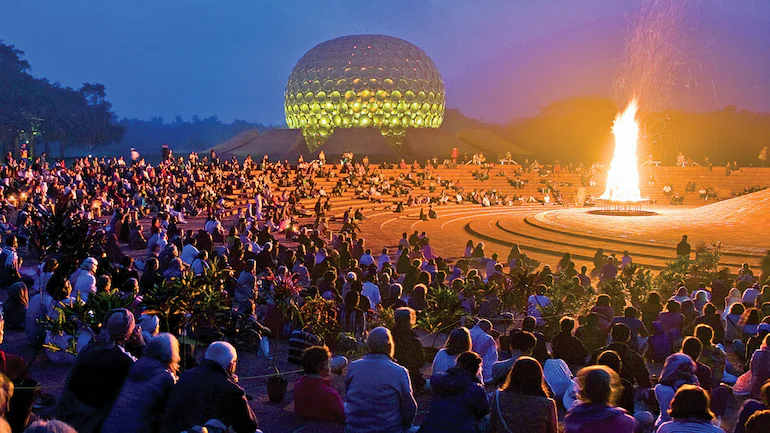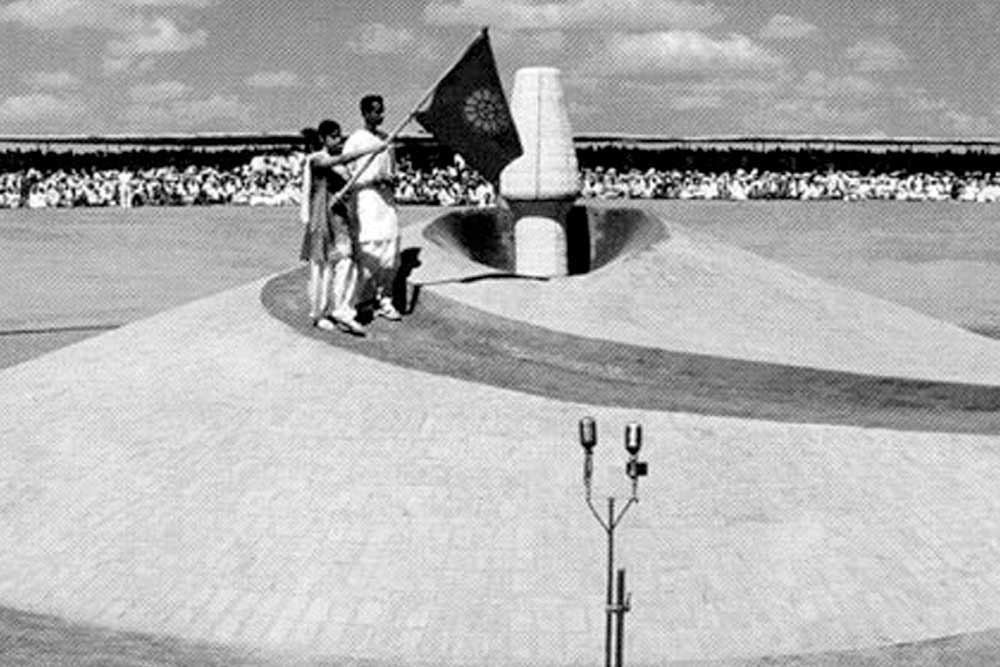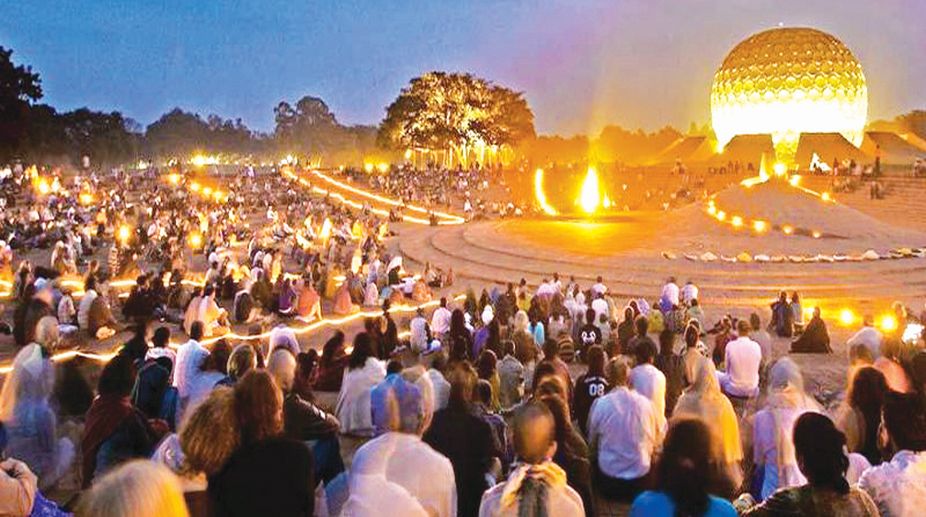Auroville Mission Statement
“Auroville wants to be a universal town where men and women of all countries are able to live in peace and progressive harmony above all creeds, all politics and all nationalities. The purpose of Auroville is to realise human unity.”
The Mother, Founder of Auroville
This was the first public message on Auroville sent into the world in 1965. Three years later, at the inauguration ceremony of Auroville on 28th February 1968, youth representing 121 nations and 23 Indian states placed a handful of earth in a lotus-shaped urn, symbolising the creation of a city dedicated to international understanding and planetary transformation.
Programmes
Envisaged as a city for 50,000 people, Auroville is an emerging township of presently about 2,500 volunteers from India and from some 50 countries around the world. Located in a rural area of Tamil Nadu, South India, it is surrounded by 13 villages with a population of approximately 40,000 people.
Over the past decades, Auroville has been dedicated to a wide range of development programmes, in many of which it has made impressive achievements. Programmes have been carried out in the following fields of activity:
Support Base
Auroville received the unanimous endorsement of the General Conference of UNESCO in 1966, 1968, 1970 and 1983. Governmental and non-governmental organisations in India and abroad have funded various development programmes. Donations have also been given by foundations in Europe and the United States, by Auroville International Centres and private donors from all over the world. The Auroville residents themselves have made a major contribution of financial resources and energy to the Auroville project.
Legal Status
In 1988, the Government of India passed the Auroville Foundation Act to safeguard the development of the International Township of Auroville according to its Charter. Under this Act, an autonomous institution, the Auroville Foundation, has been established with a Governing Board presently chaired by Mr Kireet Joshi and an International Advisory Council. In his presentation of the Act before Indian Parliament, Sri P. Shiv Shanker, the then Indian Minister of Human Resource Development, said:
“Auroville is to be looked upon as a vision which has a great potentiality and this can be of tremendous service to our country and the world at large.”
Arts & Culture
Over the past decade, Auroville has developed a multifarious cultural scene that is quite remarkable for a population of just over 2,000 people.
Many outstanding music performers, both from within India and abroad, perform regularly in Auroville. Eminent musicians such as Zakir Hussain, Shiv Kumar Sharma, Pandit Jasraj and Marcus Stockhausen have been giving concerts. Live performances by Auroville residents of western and eastern classical music, as well as of jazz and popular music, and blends of Indian and western music occur frequently. Music education is given for a variety of western and eastern instruments, such as vocals, violin, piano, flute, guitar, tabla and harmonium. Also, an adult’s and a children’s choir is regularly rehearsing and giving performances.
Resident theatre artists have created several theatre groups who perform in English or Tamil. A wide range of theatre classes, such as acting, improvisation and mime are being offered to adult Aurovilians and children alike. Teachers in the Auroville schools use original theatre, music and dance to explore body expression and induce concentration and imagination.
Auroville has been fortunate to host many visiting dancers of national and international repute, while the background of the dancers residing in Auroville is diverse. Predominant is the influence of western contemporary dance and of Bharat Natyam, the traditional dance form of the South Indian state of Tamil Nadu. Dance education follows naturally the intense dance activities and is part of the curriculum of the Auroville schools. Today classes are offered in improvisation, modern dance, Indian classical dance and African dance.
Besides local productions, international publishing companies such as Amity House, Banyans Books, Writers Workshop and Penguin have published poems from Auroville poets. One of Auroville’s Tamil poets has been officially laureated as one of the great modern poets of India.
Numerous artists resident in Auroville have studied in art institutions all over the world. They are exhibiting their works in Auroville as well as in India and in major galleries in Europe. The preferred media are oil, acrylic and watercolours, pastels, pencil and chalk. For sculpture and bas relief works a variety of materials such as terra-cotta, ceramics, plaster, wood, metal, marble and granite are being used.
Auroville is an affiliate member of RES ARTIS, an international network which promotes residential exchange programmes for artists world-wide to do research, work with other artists, and to strengthen international ties and understanding of the diverse cultural heritages that invigorate the human society.
Educational Research
Auroville’s Charter speaks about Auroville as “a place of unending education”, thus introducing the concept of a life-long process of development towards a person balanced in body, mind and spirit.
Auroville’s educational research endeavours to nurture the child’s potential to its highest possible level, and is based on a child-centred approach. A free choice system, allowing the student to increasingly choose his/her own subjects for study, is gradually being introduced, in particular in the more advanced courses. Also, sports and physical education are strongly emphasized for balanced and healthy growth of the children. Artistic training is an intrinsic part of Auroville’s system of education, which encourages the child to develop his/her artistic faculties and sense of beauty.
At present, there are crèches, kindergartens, primary schools and one high school in Auroville, next to 4 day-schools and over 15 part-time evening schools for the children of the nearby villages. About 1000 children from the neighbouring villages and from Auroville are benefiting from Auroville’s educational programme.
Research papers on Auroville’s educational work are regularly published and two major publications “The Aim of Life” and “The Good Teacher and the Good Pupil” have been produced to help invigorate a new, integral approach to education.
Education in Auroville is administered under the umbrella of the Sri Aurobindo International Institute for Educational Research (SAIIER), an organisation established in 1984 to focus on Auroville’s multi-faceted educational and cultural activities for both children and adults.
Environmental Regeneration
Auroville has gained national and international acclaim for its wasteland reclamation and reforestation work. More than 2,500 acres of near barren and visibly dying land have been transformed into a lush green area. Comprehensive contour bunding and the building of small check dams for soil and water conservation have significantly enhanced the life-support potential of the whole area. Over 2 million forest trees, hedge trees, fruit, and fuel wood trees have been planted.
The Auroville Centre for Ecological Land Use and Rural Development, “Palmyra”, has been carrying out soil and water conservation, and reforestation programmes over the last decade on almost 3,000 acres of village land with a total of more than 1.2 million trees having been planted. Palmyra also offers training programmes for farmers, NGOs, and government officers in the field of ecological and sustainable land use.
Handicrafts and Small-Scale Industries
There are more than 100 commercial units, both large and small, operated by Auroville at present. Their activities are diverse and include handicrafts (such as ready-made garments for adults and children, candle and incense products, embroidery, crochet, quilts, hand painted silk, beadwork, jewellery, postcards, leather work, pottery, paper lampshades, woodwork, etc.), printing and graphic design, food processing, electronics and engineering, computer software, windmill manufacturing, and construction and architectural services.
In terms of its own maintenance, Auroville wishes to become increasingly self-sufficient. Auroville’s commercial units have an important role to play in achieving this objective. Besides generating funds to assist the community in maintaining its basic services and infrastructure, the units provide employment and training for the local villagers, enabling them to improve their standard of living and acquire valuable skills. At present, about 5,000 villagers are employed in Auroville.
Health & Healing
Many systems of primary health care are in use in Auroville, including allopathy, homoeopathy, acupuncture, chiropody, podology, massage, chromato-therapy, and others.
The Auroville Health Centre, recognised as a Mini Health Centre by the Tamil Nadu State Government, is equipped with basic medical facilities and staffed by an international team. It serves the Auroville community as well as about 200 patients daily from the villages at its headquarters in Kuilapalayam and its sub-centres. A team of 30 local women trained as village health workers serve in 17 villages, giving first aid, home cures and basic health education. The Auroville Health Centre also runs a dental care unit, a children’s home for pediatric treatment, a medical lab, a pharmacy and a small medicinal plant garden, and offers several preventive health programmes to village women and children.
Under the aegis of The Indian Foundation for Revitalization of Local Health Traditions (FRLHT), Auroville hosts one of the 15 Medicinal Plants Conservation Parks which are being set up in the three South-Indian states of Kerala, Karnataka and Tamil Nadu. The aim of these centres is to revive the local health traditions and the ancient medical systems of India as described in the Ayurveda and its Tamil equivalent, the Siddha. For this purpose, Auroville has established an ethno-medicinal forest area to conserve medicinal plant diversity, an outreach nursery focusing on medicinal plant propagation and distribution, and a Bio-Resources Centre dedicated to education, training and research in the use of locally available medicinal plants in primary health care.
In 1997, a new healing centre complex, “Quiet”, near the beach was inaugurated to focus on providing alternative healing therapies. An international homoeopathic seminar, led by world-renowned homoeopaths from India and UK, marked the beginning of a new chapter in Auroville’s endeavour to combine new therapies with conventional health care.
Since July 2008 Kailash Clinic is operating, right in the middle of Auroville. It is a pilot project of the Integral health Services (IHS), based on an interdisciplinary approach to medicine.
It is providing doctor’s consultations, first aid and wound dressing in the morning and complementary therapies in the afternoons.
Innovative Building Technologies
Auroville has gained considerable knowledge and expertise in the field of innovative, appropriate and cost-effective building technologies, especially earth construction and ferro-cement.
Earth construction uses compressed earth blocks, made with a manual press from local earth mixed with 3-5% cement. The blocks are usually produced on the building site, without polluting the environment or depleting the forests, as no kiln firing is required.
Ferro-cement is a thin cement mortar laid over reinforcing wire mesh, thus employing steel and cement in a highly efficient and cost-effective manner. It is cheap, strong, versatile and long lasting, and the basic techniques are easily acquired, making this building technology readily accessible to the neighbouring villagers. Ferro-cement doors, roofing channels, water tanks, biogas systems, latrines and other building components are being manufactured in Auroville.
The Auroville Building Centre, which is part of a national network of more than 500 building centres all over India initiated by the Housing and Urban Development Corporation of India (HUDCO), provides regular training programmes for masons, master masons, site supervisors, contractors, engineers, and architects. It also offers consultancy, designs buildings and supervises construction sites using these appropriate, cost-effective building technologies. In 1995 and in 1996, the Auroville Building Centre received via HUDCO the yearly Outstanding Performance Award from the Ministry of Urban Development and Poverty Alleviation for its activities in this field.
Integrated Urban Planning
Auroville is located on a low-lying plateau on the south-eastern coast of India, 160 km. south of Madras. At the centre, both physically and spiritually, stands the nearly completed Matrimandir, “the soul of Auroville”. Started on 21st February 1971, construction work on this structure has continued uninterruptedly ever since. The inner chamber of Matrimandir, a place for silence and concentration, has been completed and, at present, the work focuses on finishing the outer structure and creating the surrounding gardens.
Four zones will radiate out from the Matrimandir gardens: International, Cultural, Residential and Industrial. The Green Belt, an area for promoting biodiversity, environmental restoration and organic farming, will eventually surround the entire city area. While much of the land still has to be purchased, Auroville presently manages about three-quarters of the total acreage within the future city area, and about 25% within the Green Belt.
The present community of Auroville consists of some 100 settlements of varying sizes. Auroville has created a basic infrastructure of roads, water and electricity supply, and telecommunications, including an electronic communications network. Accommodation has been constructed for 1,500 people, and municipal services for food production, purchase and distribution, electricity and water supply, waste disposal and recycling, education, health care, financial transactions, and town planning have been established.
The Auroville Township Master Plan 2000 – 2025, which has been recently endorsed by the Government of India, is dedicated to the challenge of creating an environment-friendly, sustainable urban settlement that, at the same time, integrates and cares for the neighbouring rural area.
Auroville’s concept is therefore to build a city that will economise on land needs by introducing development approaches with an optimum mix of densities and appealing urban forms and amenities, while the surrounding Green Belt will be a fertile zone for applied research in the sectors of food production, forestry, soil conservation, water management, waste management and other areas which assist sustainable development. The results of such innovative methods would be available for application in both rural and urban areas in India and the world.
Organic Farming
The development of an ecologically sound agriculture, which excludes the use of pesticides and detrimental chemicals, and the application of agro-forestry techniques are being actively pursued in Auroville. Efforts are being made with the surrounding village farmers to reverse the process of growing cash crops using chemical inputs in the form of fertilisers and poisonous pesticides such as DDT. Alternative biodegradable pesticides are being developed and marketed as part of an overall attempt to re-introduce sustainable agricultural practices throughout the bioregion.
Training programmes are regularly organised for farmers from the surrounding area. On the national level, Auroville has participated in many Indian conferences on organic farming, and hosted in April 1995 an All-India seminar on organic farming under the name “ARISE: Agricultural Renewal in India for a Sustainable Environment”.
Renewable Energy
Concerned with the ecological implications of energy consumption, Aurovilians have been experimenting with the use of renewable energy sources from the beginning. The major forms of renewable energy utilised in Auroville are solar, wind and biomass. At present, more than 1,200 photovoltaic (PV) panels are in use for electricity and water supply. Some 30 windmills of various designs are in operation for pumping water, and specially designed ferro-cement biogas systems process animal and vegetable waste to produce methane gas and organic fertilisers. Today, Auroville has become a major testing ground for renewable energy sources in India.
The Auroville Centre for Scientific Research (CSR), a research institution approved by the Government of India in 1984, is the focal point for many of these activities. It also runs “Awareness Workshops towards a Sustainable Future” for NGO’s, government officials, students and professionals on the sustainable techniques applied in Auroville.
Rural Development
Rural development has been a major activity of Auroville since its inception. There are 13 villages in the immediate neighbourhood, comprising about 40,000 people, and altogether 40 villages in the bioregional area. At present, ten Auroville working groups have dedicated themselves to fostering sustainable programmes in these 40 villages.
With funding from a number of national and international organisations, Auroville’s rural development programme aims at:
- raising the standard of living of the local population through vocational training and self-employment;
- involving the villagers in a cooperative effort of wasteland reclamation and organic farming;
- improving the health situation through education, preventive care and treatment;
- empowering women and providing education to the village children;
- encouraging in each village the growth of community spirit and a sense of self-confidence through social initiatives, micro-projects and awareness campaigns.










